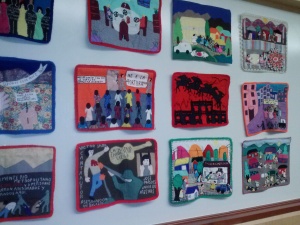They may look at first like a class cultural art project, but the 40 miniature tapestries hanging in the dean’s conference room in the College of Liberal Arts tell a much more arresting story.
These squares of colorful, hand-sewn panels are Chilean arpilleras, created by women to tell stories of oppression and resistance with images instead of words, avoiding the eye of military authorities in one of the darkest periods of Chilean history.
The arpilleras come from various exhibits in American museums, collected for this showing at Towson University with help from poet Marjorie Agosin.
“The arpillera is born from deep inside of us, in a zone of intimacy,” Agosin writes in her book, “Tapestries of Hope, Threads of Love.” “But it embodies the public voice and allows hands… to tell their story.”
According to the Royal Alberta Museum, Chilean women made arpilleras by candlelight to avoid the attention of Augusto Pinochet’s military during his presidency. His rise to power followed a military junta and ushered in more than 15 years of terror that included more than 130,000 politically motivated arrests and disappearances. Often, the arpilleras reflect a missing father, brother or son—taken by Pinochet’s forces without warning or explanation.
“The arpilleras belong to a long history of women weaving or seweing to express what they could not voice,” says Philosophy and Religious Studies Department Chair Anne Ashbaugh. “We find this tradition encoded in Greek mythology…and then again among American women’s cloth crafts, quilting in Ireland or the woven rugs in Afghanistan.
“There is a common thread—no pun intended—that binds women’s resistance.”
The arpilleras quietly turned Chilean women into revolutionaries. The Royal Alberta Museum explains that Chilean government officials could not fathom that these women could be organized in their opposition to the Pinochet regime, even while they were marching to the Supreme Court in Santiago every week, chaining themselves to fences in front of Pinochet’s house, and participating in hunger strikes. “They used their traditional role to their advantage and publicly opposed a system incapable of recognizing them as anything other than mother or wife,” the museum’s exhibit website explains.
“Our students and the community benefit not only from the beauty of the art, but also from the history these images embody,” Ashbaugh says.
The exhibit is open from 11 a.m. to noon Mondays, Tuesdays and Thursdays, and by appointment. It will remain for public view in the dean’s conference room on the second floor of the CLA building through January 5, when it returns to Agosin at Wellesley College. The exhibit was funded by the college and a grant from Mary Wong to support events involving philosophy and the arts in memory of Dr. Wing-Chun Wong. Dr. Wong taught in TU’s philosophy department until his passing in 2001.

